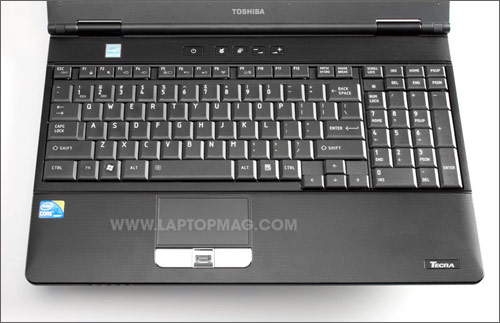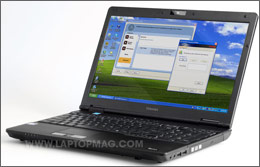Laptop Mag Verdict
This mainstream business system has plenty of power and business features, but is somewhat bland.
Pros
- +
Long warranty
- +
Good business and security features
- +
Strong performance
Cons
- -
Limited viewing angles
- -
Tinny speakers
- -
Not the best bargain
Why you can trust Laptop Mag
Small business owners and entrepreneurs need to scrimp and save any way they can, which is why systems such as the Toshiba Tecra A11 represent a real deal. For $879, users get a fairly powerful system, a large 15.6-inch display, and security and IT features that would otherwise be too costly for a start-up. But is this the best bargain for penny pinchers?
Editors' Note:While the A11 comes preinstalled with Windows XP Professional, Toshiba packages Windows 7 Professional with the system, which we installed prior to running our benchmark tests.
Design
Although business notebooks aren't known for their flair, more consideration is given now to their looks. The A11's matte black lid is dimpled with a stylish pattern that doesn't show fingerprints, and it continues on the deck; the bezel is also a matte black plastic, but lacks the design. Overall, it's a very understated look that will no doubt appeal to business users, but it lacks the full panache of the HP ProBook series, which has a more elegant brushed aluminum lid.
Above the keyboard are buttons for launching Toshiba's Eco Utility, outputting the screen to a projector or larger display, and volume controls. These are handy to have, but we think they would be better put to use if they offered quick access to, say, PowerPoint or some other business-centric function.
Measuring 14.7 x 9.9 x 1.3--1.5 inches and weighing 5.6 pounds, the A11 is a bit too bulky to carry around; those who travel often should look elsewhere.
Heat
The large chassis of the A11 kept the system relatively cool while streaming a Hulu video at full screen. After 15 minutes, the touchpad was 90 degrees Fahrenheit, the space between the G and H keys reached 95 degrees, and the middle of the underside was 97 degrees. Still, this system was working hard: the underside by the exhaust vent measured 105 degrees.
Keyboard and Touchpad
The A11's deck is large enough to comfortably fit a full keyboard and number pad. The black matte lids are of the traditional variety, had a nice textured surface, and responded well when typing. We were up to our usual speed in no time.
The 3 x 1.6-inch touchpad is comfortably large, and its surface let us move around with ease. Below, the two mouse buttons (separated by a fingerprint reader) are made of a shiny metallic plastic, which makes them really stand out on the all-black deck. Despite picking up fingerprints, the buttons were large and responsive when pressed.

Click to enlarge
Display and Audio
The 15.6-inch display on the A11 has a resolution of 1366 x 768; if the screen were any larger, pixels would start to look a little too large, but here, it's good for having two windows open side by side. The screen has a glossy finish, which is unusual for a business notebook; this makes it more reflective than we'd like. Horizontal viewing angles were wide enough so that two people could sit on either side of the screen, but vertical viewing angles were much more limited; we found that the ideal position was 10 to 15 degrees past vertical.
The stereo speakers, mounted on the left and right front of the system, were very loud for a business notebook. Bruce Springsteen's "Born to Run" blared out as if we were at the Stone Pony ourselves, but lower tones were sadly lacking, drowned out by treble notes that became harsh as we cranked the volume to its max.
Durability and Security
Chances are, a notebook such as the A11 will see a lot of use in its lifetime, which is why Toshiba outfitted the machine with what it calls EasyGuard Technology: hardware and software features designed to increase its longevity. This includes a 3D accelerometer that parks the hard drive in the event the notebook is jarred, and shock absorbers that further protect the hard drive and other components such as the LCD panel.
On the security front, the A11 includes the aforementioned fingerprint reader between the mouse buttons, Infineon Trusted Platform Module Software (which encrypts the hard drive), and Toshiba's Secure Digital Token Utility, which lets consumers use an SD Card as a key to access the notebook.
Ports and Webcam
The A11 comes with a healthy selection of ports, including three USB, an eSATA/USB, DisplayPort, VGA, Serial, Ethernet, modem, headphone, and mic. One of the USB ports, as well as the eSATA/USB port, can charge connected devices while the system is turned off. The system also has a 7-in-1 memory card reader and an ExpressCard/54 slot.
The A11's webcam proved adequate for video conferencing. Over Skype, there was plenty of detail in our face, but colors were muted; our skin took on a bluish tone.
Performance

Click to enlargePowered by a 2.13-GHz Intel Core i3-330M processor and 2GB of RAM (expandable to 8GB), the A11 scored a very strong 4,565 on PCMark Vantage, about 750 points above the mainstream average, and 1,200 points above the HP ProBook 6545b, which sports a 2.3-GHz AMD Turion II Dual-Core M520 Mobile Processor and 2GB of RAM. This system offers plenty of pep for everyday business tasks, but power users should keep in mind that the A11's processor can't overclock on the fly, such as Core i5 and i7 systems; for example, the Acer Aspire 5740G--which has a Core i5 CPU--scored about 1,300 points higher than the A11.
The 5,400-rpm, 250GB hard drive performed on the slow side, duplicating a 4.97GB folder of multimedia in 4 minutes and 24 seconds, a rate of 19.3 MBps. That's about 2 MBps slower than the average, and well below notebooks such as the HP ProBook 5310m (26.2 MBps) and the Lenovo Thinkpad SL510 (29.2 MBps).
Using Oxelon Media Converter, the A11 transcoded a 114MB MPEG-4 to AVI in 1 minute and 10 seconds, about 10 seconds longer than average.
Packing an integrated Intel GMA HD graphics chip, the A11 has no aspirations of reaching gaming notebook status. However, business users looking to procrastinate will be able to play mainstream titles on the notebook, albeit without all the eye candy turned on. In World of Warcraft, when we turned the resolution to 1024 x 768 and set effects to default, we saw a very decent frame rate of 46 frames per second. At native resolution and effects at max, that figure dropped to an unplayable 9 fps.
Battery Life and Wi-Fi
It's unlikely that the A11 will spend much time away from an outlet, but it's nice to know that it can. On our LAPTOP Battery Test (web surfing via Wi-Fi), the A11 lasted 4 hours and 37 minutes, an hour longer than the mainstream average, but equal to the HP ProBook 4720s, which has a larger 17-inch screen.
Wi-Fi throughput was also very strong. The Intel Centrino Advanced-N 6200AGN 802.11a/g/n radio saw throughput of 38.5 Mbps at 15 feet from our router, and 25.7 Mbps at 50 feet.
The A11 also comes installed with Intel's My WiFi technology; once enabled, it allows the user of the A11 to share his or her Internet connection, creating an ad-hoc wireless network.
Green Testing
The A11 has an excellent EPEAT rating of 22 out of 27; the notebook took 1 hour and 21 minutes to recharge to 80 percent, and another half hour to fully recharge. During that time, it drew an average of 46 watts. Its LAPTOP Battery Efficiency Rating (total watts divided by battery life) of 18.4 is about 27 points below the mainstream average, where lower numbers are better.
Configurations

Click to enlargeToshiba offers five different preconfigured versions of the A11, and lets consumers customize the notebooks, too. Our version, which sells for $879, was the base model. For $1,349, users get an Intel Core i7-620M processor, 4GB of RAM, a 1600 x 900-pixel screen, Nvidia NVS 1200M graphics, and a 7200-rpm, 320GB hard drive.
Software and Warranty
The usual array of software is preloaded on the A11, including a 30-day trial of Norton Internet Security 2010, a 60-day trial of Microsoft Office, and Intuit QuickBooks. Other Toshiba-centric apps include its Bulletin Board (not entirely useful on a non-touchscreen system) and ReelTime, which sorts documents and files along a timeline that runs across the bottom of the screen.
The A11 comes with a longer-than-usual three-year warranty and 24/7 phone support. To see how Toshiba fared on our Tech Support Showdown last year, click here.
Verdict
In the Tecra A11, Toshiba has created a very capable and affordable system for small business users. For $879, you get a fairly powerful processor, useful productivity features (such as the ability to create a hotspot on the fly), and budget-minded security utilities like Secure Digital Token. And if all that fails, Toshiba's three-year warranty is very reassuring. Still, before taking the plunge, you can stretch out your funding even more with the HP ProBook 4520s, which features a 2.13-GHz Intel Core i3-350M processor, a larger (and faster) 7,200-rpm, 320GB hard drive, and a lighter design, all for an affordable $719. But you would be wrong to dismiss the Tecra A11 out of hand. It may not have a lot of flair, but it sure gets the job done.
Toshiba Tecra A11 Specs
| Bluetooth | Bluetooth 2.1+EDR |
| Brand | Toshiba |
| CPU | 2.13GHz Intel Core i3-330M |
| Card Slots | 7-1 card reader |
| Company Website | http://www.toshiba.com |
| Display Size | 15.6 |
| Graphics Card | Intel GMA HD |
| Hard Drive Size | 250GB |
| Hard Drive Speed | 5,400rpm |
| Hard Drive Type | SATA Hard Drive |
| Native Resolution | 1366x768 |
| Operating System | Windows 7 Professional |
| Optical Drive | DVD SuperMultiDrive |
| Ports (excluding USB) | Headphone, Ethernet, eSATA/USB, VGA, DisplayPort, serial, Modem, Microphone |
| RAM | 2GB |
| RAM Upgradable to | 8GB |
| Size | 14.7 x 9.9 x 1.3 - 1.5 inches |
| USB Ports | 3 |
| Warranty/Support | 3 years/24/7 |
| Weight | 5.6 pounds |
| Wi-Fi | 802.11a/g/n |
